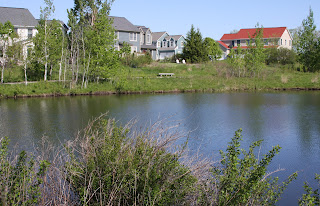Runoff from a variety of land uses, including agriculture and industry, has been identified as one of the primary causes of harmful algal blooms (PDF) in the Great Lakes and surrounding waterways. The danger of these algal blooms comes in the form of botulism outbreaks, toxins, and harmful metabolites – all of which can have serious consequences for native plants, fish, and human health.
One potential solution that has been in use in Ohio is the planting of radishes, not only to help manage water and runoff, but also to improve soil quality for agricultural users.
“The radishes planted in northwest Ohio go in about this time of year and are left in the ground to die, explained our host, Allen Dean. Planting doomed radishes, it turns out, is an innovative technique he has used in recent years to improve soil nutrients and reduce runoff from his Williams County farm.
Here’s the basics on how it works: Farmers plant seeds for a plant called an oilseed radish. It doesn’t actually have to be that plant, but it needs to grow a foot or longer into the soil during the fall in a tubular shape, like a carrot or a parsnip. It also needs to grow a fair amount of foliage up on the ground. Radishes are usually more affordable.
It’s important that the plant drill down into the soil so that when it dies, usually during a mid-January freeze, it decays and leaves behind a v-shaped hole for snow and water to penetrate deeper. The decayed radishes Dean showed us looked like organic socks.
Oilseed radishes are particularly good at absorbing nutrients from the surface and sending them down into the soil as the tubular plant drills it way into the ground.”
Read the complete article above to find out more about how these plants are helping farmers and protecting the Great Lakes waters at the same time.
One of the unsung agencies that is heavily involved in restoring coastal ecosystems just happens to be one of the biggest and most crucial – The U.S. Army Corps of Engineers.
The U.S. Army Corps of Engineers and their Ecosystem Restoration Program are heavily involved in planning, developing, and executing projects that restore damaged ecosystems and areas and provide environmental benefits to communities, including several projects in and around the Great Lakes.
“The USACE works to restore degraded ecosystems to a more natural condition through large-scale ecosystem restoration projects, such as the Comprehensive Everglades Restoration, Louisiana Coastal Area Ecosystem Restoration, Chesapeake Bay Oyster Recovery, Aransas National Wildlife Refuge Beneficial Use of Dredged Material (restoration of marsh critical to the endangered Whooping Crane), and Houston Ship Channel Beneficial Use of Dredged Material (marsh restoration in Galveston Bay), and by employing system-wide watershed approaches to problem solving and management for smaller ecosystem restoration projects.”
Read more about this terrific program and about the substantial work that goes into these projects at the article linked above.
A lot of people are probably familiar with the streams, lakes, and rivers near where they live. Many people might even be able to point out where their local water treatment plant is. But what a lot of people might not know is that the water we use often comes from a long, long way away.
Watersheds are areas where water comes together and drains to a common place. In addition to the streams and rivers and creeks that we can see, though, watersheds encompass a huge range of pathways for water, and your nearby water supply might be part of a very large system that spans multiple states.
As a result, even in areas where there aren’t necessarily rivers nearby, what goes into our water directly or indirectly can have a big impact. Development and sprawl, even well outside of cities and away from rivers or lakes, can have a significant effect, and that is the focus of a recent article from The Atlantic Cities:
“Of course, obtaining sustainable development in town isn’t enough, in and of itself, to guarantee high quality, fishable and swimmable rivers and streams. Industry plays a part; utilities and waste water treatment plants play a part; sensitive farming, ranching, and/or timbering play a part, all in different proportions depending upon the particular watershed in question.”
The interconnectedness of watersheds is one of the main motivations behind initiatives like
Lawn to Lake and
Unwanted Medicines – keeping the bad stuff out of our water protects people, plants, and animals across a wide region.





